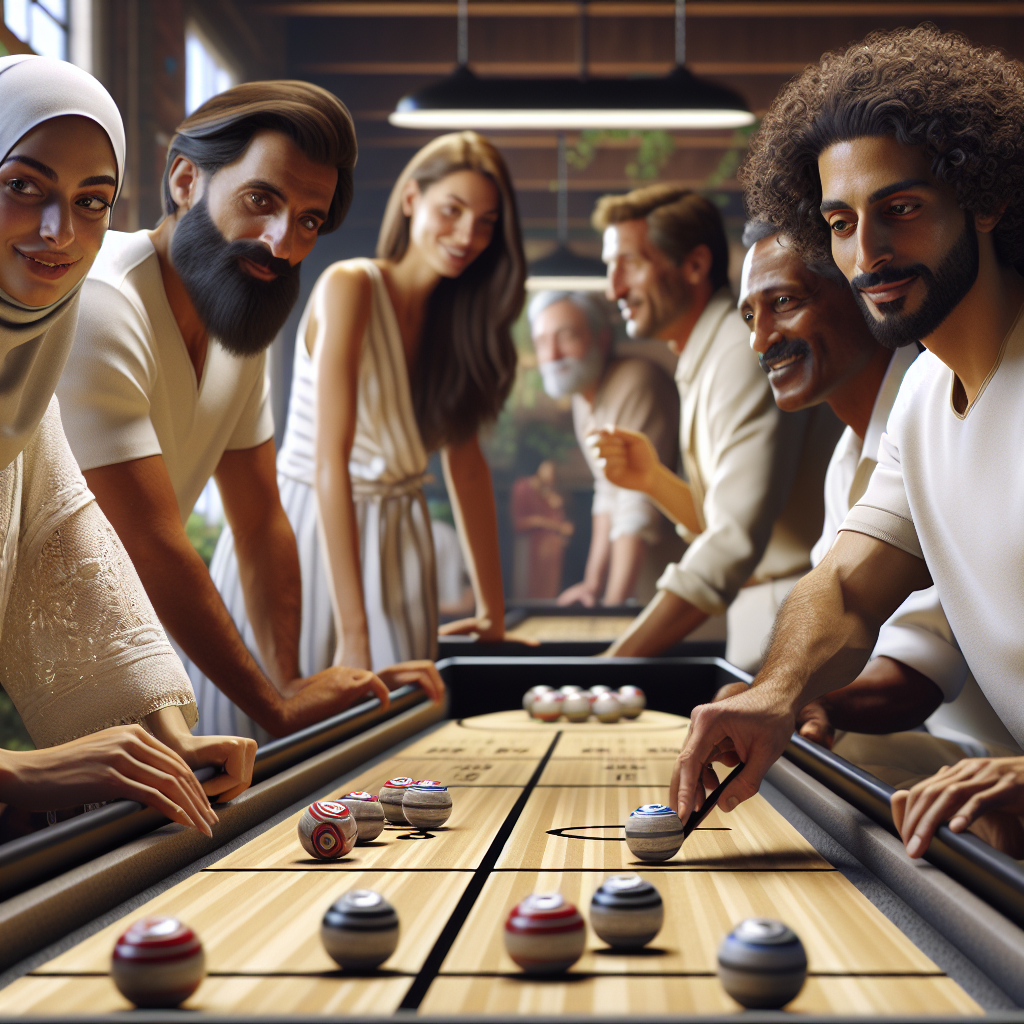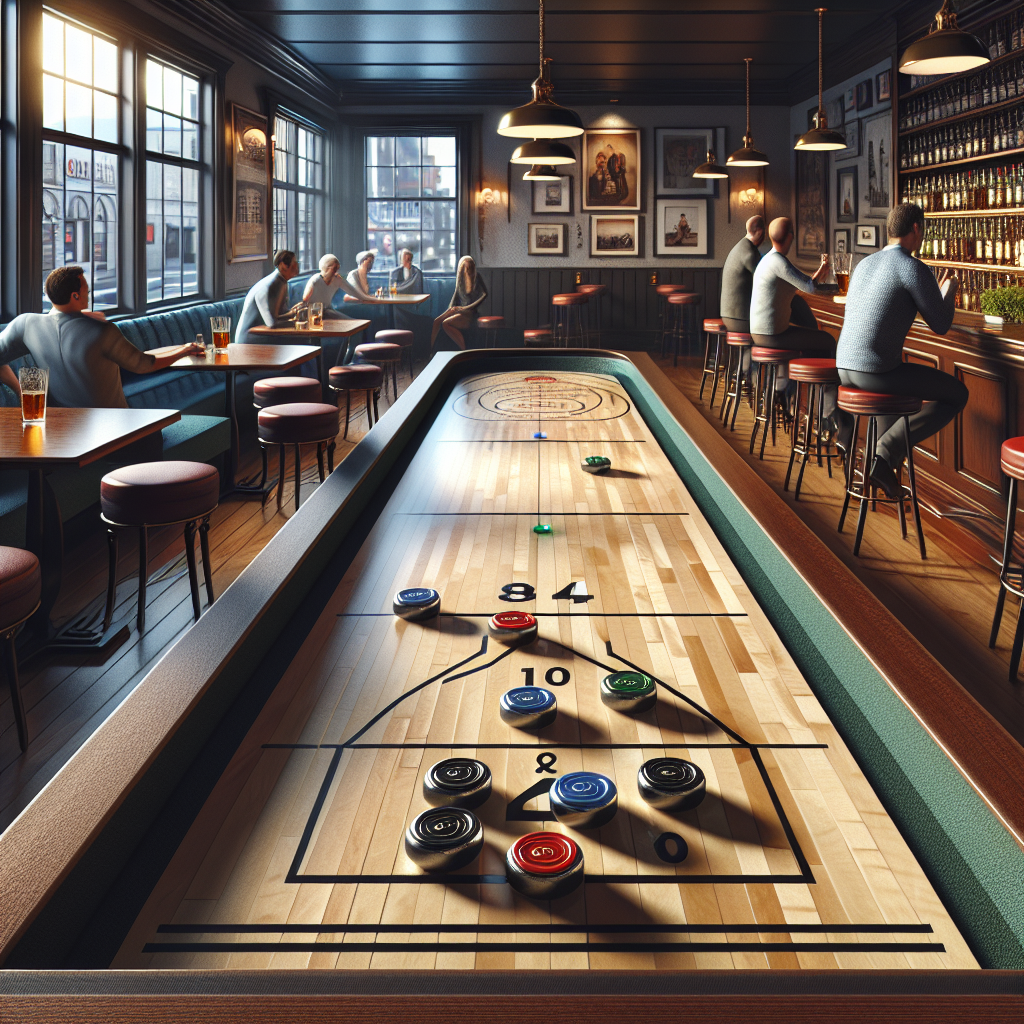Understanding Shuffleboard Basics
To excel in the game of bar shuffleboard, it’s essential to have a solid grasp of the game’s basics. This section provides an overview of the gameplay and scoring system.
Gameplay Overview
In bar shuffleboard, players take turns sliding their weighted pucks, also known as discs or weights, down a long and narrow table. The objective is to land the pucks in specific scoring areas without falling off the board. The gameplay involves skillful sliding and strategic decision-making to outscore opponents.
Players typically compete in pairs or teams, with each player or team alternating turns. The game begins with a coin toss or another method to determine the starting player or team. The first player or team then slides all four of their pucks against the opponent’s pucks, aiming to reach the highest scoring area without falling off the board.
Throughout the game, players employ various strategies to knock off opponents’ pucks, outdistance them, or protect their own highest scoring pucks. The player or team with the highest score at the end of the game wins.
For a more detailed guide on how to play bar shuffleboard, refer to our article on how to play bar shuffleboard.
Scoring System
The scoring system in bar shuffleboard revolves around landing pucks in specific scoring zones on the table. The table is divided into zones that are worth different points based on their proximity to the end of the board.
The scoring zones typically include the 10-off zone (worth 10 points), the 8-off zone (worth 8 points), the 7-off zone (worth 7 points), and the 10-to-7 zone (where discs are worth their face value). Landing a puck fully within a scoring zone counts towards a player’s score, while pucks hanging over the edge or touching the line do not count.
The closer a puck is to the end of the board, the higher the point value it earns. Players aim to accumulate points by strategically placing their pucks in the highest-scoring zones while preventing opponents from doing the same.
For a more detailed explanation of the scoring system in bar shuffleboard, refer to our article on bar shuffleboard scoring.
Understanding the gameplay and scoring system of bar shuffleboard is crucial for honing your skills and developing effective strategies. By familiarizing yourself with the rules and principles of the game, you can enhance your performance and fully enjoy the excitement of bar shuffleboard.
Shuffleboard Rules and Variations
To fully enjoy the game of bar shuffleboard and master its techniques, it’s important to understand the rules and variations. Let’s explore some common shuffleboard games and their specific rules.
Common Shuffleboard Games
The most common shuffleboard games are typically played to either 15 or 21 points (McClure Tables). These games often involve sliding weighted pucks down a long and narrow table, aiming to land them in specific scoring areas divided into zones with varying points.
Game Specific Rules
Shuffleboard rules may vary slightly based on the specific game being played. Here are some popular shuffleboard variations:
-
Knock Off Shuffleboard: In this game, the objective is to knock off your opponent’s pucks from the scoring zones while keeping your own pucks on the board.
-
Horse Collar Table Shuffleboard: This game combines elements of both regular shuffleboard and curling. Players aim to slide their pucks through a horseshoe-shaped scoring zone, known as the “horse collar,” to earn points.
-
Tap & Draw Shuffleboard: In this variation, players take turns tapping their own pucks to move them closer to the scoring zone or drawing an opponent’s puck away from the zone.
-
How To Play Shuffleboard Crazy Eight: Crazy Eight is a fast-paced and exciting shuffleboard game where players aim to score exactly eight points.
-
Target Table Shuffleboard: Target shuffleboard is played on a table divided into different scoring zones. Players aim to slide their pucks into specific zones to earn points.
It’s always important to familiarize yourself with the specific rules of the shuffleboard game you’re playing, as slight variations in scoring and gameplay can greatly impact strategy and technique. For a detailed breakdown of shuffleboard scoring and the different scoring zones, visit our article on bar shuffleboard scoring.
Remember, mastering the rules of the game is just the first step. To enhance your shuffleboard skills, explore advanced techniques and strategies in our section on Advanced Shuffleboard Techniques.
Shuffleboard Table Maintenance
To keep your shuffleboard table in optimal condition and ensure a fantastic playing experience, proper maintenance is essential. Regular maintenance tasks include waxing the table for smooth gameplay and cleaning and polishing the surface to maintain its shine and protect it from wear and tear.
Importance of Table Waxing
Waxing the shuffleboard table is crucial for playing the game effectively. A poorly waxed surface can lead to mistakes in aiming, affecting the speed and direction of the puck. The quality of the surface plays a significant role in determining the outcome of movements during the game (Game Tables Online).
Waxing the shuffleboard involves using wax powder, also known as cheese, powder, or dust, which comes in yellow and brown colors. The choice of color depends on the desired speed for the shuffleboard. The wax powder is a mix of silicone and cornmeal, and it should be spread evenly and lightly using gentle sweeping motions to ensure a smooth movement of the puck (Game Tables Online).
Consistent arm movements in the same direction during cleaning and waxing of the shuffleboard help maintain a smooth and slick surface, ensuring the longevity and optimal condition of the board. This practice allows for better control over the puck during gameplay (Game Tables Online).
Cleaning and Polishing Tips
Regular cleaning and polishing of a shuffleboard table is essential to maintain its shine and protect the surface from wear and tear. It is recommended to clean and polish the table at least once a month, or more frequently if it sees heavy use. Follow these steps for effective cleaning and polishing:
-
Remove dust and debris: Use a soft cloth to remove any dust or debris from the playing surface. This helps prevent scratches and ensures a smooth playing experience.
-
Mild cleanser: Dilute a mild cleanser in water and dampen a soft cloth with the solution. Gently wipe the surface of the shuffleboard table to remove any dirt or stains. Avoid using harsh chemicals or abrasive cleaners that can damage the surface.
-
High-quality polish: Apply a high-quality shuffleboard polish to the playing surface. Follow the manufacturer’s instructions on the polish bottle for the best application method. Use a soft cloth to evenly spread the polish and buff the surface to restore its shine.
-
Shuffleboard wax or silicone spray: After cleaning and polishing, the shuffleboard should be sprayed with silicone spray meant for shuffleboards to create a smooth surface. The silicone spray should be spread evenly using sweeping motions, and excess spray should be gently mopped up with a soft cloth (Game Tables Online).
Regularly cleaning and buffing the shuffleboard playing surface is crucial to maintaining its optimal condition and ensuring a fantastic playing experience. This process removes dust and debris, cleans the surface, and applies shuffleboard wax or silicone spray to create a smooth and fast playing surface. It helps protect the surface from wear and tear while providing a superior playing experience (Gaming Blaze).
By following a regular maintenance schedule and properly cleaning, polishing, and waxing your shuffleboard table, you can ensure its longevity and enjoy smooth gameplay for years to come. Don’t forget to check out our article on bar shuffleboard tips for additional guidance on improving your shuffleboard skills.
Advanced Shuffleboard Techniques
To elevate your bar shuffleboard game, mastering advanced techniques can give you a competitive edge. In this section, we will explore three key techniques: reviewing competitor weaknesses, perfecting throw accuracy, and learning new strategies.
Reviewing Competitor Weaknesses
Understanding your opponents’ weaknesses is a crucial aspect of strategic gameplay. By observing how they approach the game, you can identify patterns and tendencies that can be exploited to your advantage. Pay attention to their shooting style, preferred shot types, and areas where they may struggle. This knowledge allows you to adjust your strategy and make calculated moves to gain an upper hand.
Perfecting Throw Accuracy
Throw accuracy is a vital skill to master in bar shuffleboard. The ability to consistently place your pucks in desired positions can greatly impact your scoring potential. Practice controlling the force and angle of your throws to ensure the puck reaches the desired target. By honing your accuracy, you can strategically position your pucks to block opponents or secure points in high-scoring areas.
Learning New Strategies
Continual learning and exploration of new strategies are essential for growth in bar shuffleboard. Familiarize yourself with a variety of techniques and tactics that can help you outmaneuver opponents and maximize your scoring potential. Some advanced strategies include:
- Bank Shots: Strategically positioning your pucks to block opponents’ scoring paths and limit their options.
- Hammer Shot: Forcefully clearing the board of opponents’ pucks to prevent them from scoring.
- Hide: Utilizing a defensive approach to protect high-scoring pucks from opponents.
By incorporating these strategies into your gameplay, you can adapt to different scenarios and increase your chances of success.
Remember, practice is key to refining these advanced techniques. Regularly engage in friendly competitions, join shuffleboard leagues, or participate in tournaments to gain valuable experience and continuously improve your skills.
As you become more proficient in reviewing competitor weaknesses, perfecting throw accuracy, and learning new strategies, you’ll find yourself gaining confidence and achieving better results on the shuffleboard table. Keep exploring new techniques, adapt to different playing styles, and enjoy the thrill of the game. For more tips and guidance on bar shuffleboard, check out our article on bar shuffleboard tips.
Strategies for Shuffleboard Success
To excel at shuffleboard, players can employ various strategies that enhance their chances of success. Two key strategies for achieving success in shuffleboard are utilizing angles and ricochets and protecting pucks while blocking opponents.
Utilizing Angles and Ricochets
Angles play a vital role in scoring and sabotaging opponents in shuffleboard. By using the side rails and ricocheting pucks off them, players can bypass or knock off opponents’ pucks. Mastering angles provides flexibility in shooting pucks and can lead to chain reactions for scoring (HB Home Furnishings).
Strategic utilization of angles involves considering the position of opponents’ pucks and the available scoring areas. By calculating the trajectory and force of the shot, players can strategically ricochet their pucks to dislodge opponents’ pucks or redirect their own pucks to favorable scoring zones. This technique requires practice and precision to maximize its effectiveness.
Protecting Pucks and Blocking Opponents
Protecting pucks by mastering the technique of blocking is crucial in shuffleboard to prevent opponents from easily bumping pucks off the edge of the court. Setting up blocking pucks strategically can also lead to scoring additional points while safeguarding high-scoring pucks (HB Home Furnishings).
Strategic puck placement can create obstacles for opponents, making it difficult for them to score or displace your pucks. By positioning pucks strategically along the court, players can effectively block opponents’ scoring paths and increase their chances of winning.
To block opponents effectively, players should anticipate their opponents’ moves and try to position their pucks in a way that hinders their progress. This defensive strategy requires careful planning and an understanding of the game dynamics.
By utilizing angles and ricochets while protecting pucks and blocking opponents, players can significantly improve their shuffleboard game. These strategies require practice, precision, and a deep understanding of the game to execute successfully. For more tips and techniques on shuffleboard strategy, check out our article on bar shuffleboard strategy.
Enhancing Shuffleboard Performance
To improve your performance in bar shuffleboard, there are a few key elements to focus on: proper grip and stance, as well as avoiding common mistakes.
Proper Grip and Stance
Having a proper grip and stance is essential for accuracy and control in shuffleboard. When gripping the puck, it’s important to find a balance between a firm grip and not gripping too tightly. This allows for better control during the delivery. Additionally, maintaining a balanced and stable stance is crucial. Position your feet shoulder-width apart, with your knees slightly bent for stability. This stance provides a solid foundation, allowing you to maintain control and execute precise shots.
For more specific information on grip and stance techniques tailored to the Playcraft shuffleboard, refer to the manufacturer’s guidelines or consult with experienced players. Proper grip and stance are fundamental to enhance accuracy and overall performance when playing on the bar shuffleboard table.
Avoiding Common Mistakes
In shuffleboard, there are common mistakes that can hinder your success. By being aware of these pitfalls, you can avoid them and improve your performance. Here are some key areas to focus on:
-
Misjudging Speed and Distance: Properly judging the speed and distance of your shots is crucial. Factors that can affect speed and distance include the weight of the puck, force of the push, texture and condition of the playing surface, shot techniques, visual markers, and obstacles or bumpers on the table. Take these factors into consideration and practice to develop a better understanding of how they affect your shots.
-
Delivery Technique: Proper technique in the delivery is essential for accurate shots. Avoid gripping the puck too tightly, as this can affect the smooth release. Focus on a smooth and controlled release, following through with the delivery for power and control. Maintain a balanced and stable stance with feet shoulder-width apart and weight evenly distributed.
-
Lack of Strategic Planning: Shuffleboard is not just about making shots; it’s also a game of strategy. Failure to strategize and plan ahead can hinder your success. Understand the layout of the board, anticipate your opponent’s moves, and develop a game plan. Control the speed and direction of your shots, utilize different shooting techniques, and adjust your strategy as the game progresses.
By avoiding these common mistakes and focusing on grip, stance, accuracy, and strategic planning, you can significantly enhance your performance in bar shuffleboard. Remember, practice is key to improving your skills and becoming a more proficient player. Enjoy the game and embrace the challenge of continuously improving your shuffleboard abilities.







